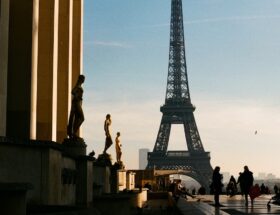By Pauline Weston Thomas for Fashion-Era.com
Fashion Quizzes, Puzzles,& Fun - Fashion Trivia 1 Answers 80 Mixed General Costume & Fashion History
- Mary Quant. By 1966 Mary Quant was producing short waist skimming mini dresses and skirts that were set 6 or 7 inches above the knee. It would not be right to suggest she invented the mini. In 1965 she took the idea from the 1964 designs by Courrèges and liking the shorter styles she made them even shorter for her boutique Bazaar. She is rightly credited with making popular a style that had not taken off when it made an earlier debut.
- The modern version was patented by Louis Reard in 1946. His design was more akin to the skimpy string 1970's bikinis. Bikinis made news then and as versions have become skimpier they have always attracted attention. When the Bikini was named its impact was likened to an atomic explosion. Cotton batik bikini worn by a teenager - 1980s. Bikinis were seen in Crete thousands of years ago. After that pictorial evidence of 200 A.D., suggests that bikini clad women were cavorting in Sicily's Piazza Armerina.
- Collagen injections for lips, botox for frown lines and wrinkles.
- The smallest female feet to be found in the UK today are in Pontypridd in South Wales, UK, where women there often have feet UK sized 2 or 3 (35).
- Miss Marilyn Monroe had shoe adjustments so she could sway when she walked. Her swaying hips helped make her appear more vulnerable, increasing her sexual appeal.
- Miss Naomi Campbell was wearing very high platform shoes during Vivienne Westwood's fashion show.
- TV dramas like 'Dynasty' and 'Dallas' brought fashion into real everyday eighties life. In particular, 'Dynasty' the 1980's television fantasy soap series promoted fashions which enlarged the shoulder. One of the main characters was played by the naturally broad shouldered film star Linda Evans. Nolan Miller, the costume designer decided to go with her big shoulders and give slight emphasis to them. Every other actor had to be shoulder padded, but with more depth to match her shoulders. In the 1980s 'Dynasty' was watched by a global audience of over 250 million viewers. Throughout the 80s styles did filter to the mass market in watered down versions. 1980's fashion favoured applied decoration on suits and T-shirts and beadwork on clothing which all pandered to the ideals of a time of conspicuous consumption.
- The Clothes Horse Ambassadress of Fashion was Diana Princess of Wales. By the 1990s she was a world leader of fashion in clothes, accessories, make up and hair. She became a trendsetter hounded by the press for her latest look, latest remark or latest romance. High street stores and brand labels eagerly copied her outfits and customers in the 30-45 age group recognised her as their fashion leader, copying all her trademarks of style even her fitness fever. She gave new impetus to the millinery trade with her early passion for hats and once more it became stylish for everyone to wear hats at weddings. She gained world television coverage daily to the largest number of people ever. She was easily the most influential fashion icon of the 20th century exhibiting flair and a dash of daring.
- A muslin mock up of a dress. Designers create their initial designs either by using muslin, which drapes well for flowing designs or by using linen canvas or calico for more structured garments such as tailored garments. These sample models are called toiles and save using very expensive fabrics that can cost a £100 or more a metre.
- New Romanticism was a manufactured scene within London nightclubs in the early 1980s. The posers within the group, often the more creative people who had always been more interested in the sartorial aspects of dressing up than the anarchic statement of punk anti fashion, looked for new ideas to draw attention to themselves. The flamboyant, colourful dramatic look used frills and luscious fabrics associated with historical periods. Adam Ant a new romantic pop star who epitomised the more beautiful aspects of New Romantiscm.
- Doc Martens. In the late 70s young people suddenly adopted Doc Martens sensible laced up shoes as a fashion accessory to the delight of podiatrists everywhere. Young girls suddenly took on a different look in their solid Doc Martens footwear and dainty Laura Ashley fine cotton lawn feminine floral dresses.
- Grunge was based on fashion started by a youth cult in the Pacific North West region of America in the early 1990s. The key to the look was that nothing matched, nothing was coordinated and an item was preferable if old and worn. It is frequently used now to describe unattractive fashion features or unkempt individuals or uncoordinated unmatched styles.
- A Novak is a cult designer limited edition bag designed by Alexander McQueen in 2005.
- John Paul Gaultier.
- Donna Karan designs for women on the go. She uses quality jersey with Lycra and great cutting to produce capsule wardrobe garments that hide real women's body defects.
- Pashminas. By the year 2000 Pashminas were a mass fashion and many moved onto newer ideas. It did not go away however as many found it so useful. It returned with expensive embroidery or beadwork in 2001.
- In the late fifties we were called the Affluent Society. Mr. Harold Macmillan's phrase 'you've never had it so good' echoed throughout the realm. Despite inflation, those few words have a meaning as true today as when they were first spoken.
- Lightweight tweeds.
- Antique - over 100 years old would be the strict definition. But now often taken to mean anything from 1920 or earlier when referring to clothing. As they become rarer these garments and accessories are frequently the type of items museums like to get their hands on. Museums like to fill gaps in their collections. They also like to create themes or collections based around an art movement like Art Deco or Baroque.
- Vintage - This is anything from 1920 onward to 1960. After that date an item is retro.
- Since 1951.
- Jacqueline Kennedy later known as Jacqueline Kennedy Onassis.
- Kelly bag.
- House of Gucci.
- Ready to wear.
- Eau de parfum.
- Stella McCartney.
- Yuppies - Young Urban Professionals. Yuppie was an acronym for 'Young Upwardly Mobile Professional Person'. The word was coined by the advertising industry to capture the essence of a particular type of work hard, play hard, ambitious minded city career person of either sex. The hectic lifestyle of a yuppie meant that after long hours of work, rare free time was spent in a self indulgent way frittering away the cash earned on anything, from expensive make up and perfume, to a bottle of fine champagne. Conspicuous wastage was part of the attitude.
- The Chanel No.5 advert with Nicole Kidman.
- Elizabeth Taylor.
- Gianni Versace.
- Cashmere fibre is from the Kashmir goat .
- The angora goat produces fibre which become mohair.
- The angora rabbit produced hair which is made into angora or bunny wool.
- Pucci.
- The first face lift was done by Eugene Hollander of Berlin in 1901.
- Katharine Hamnett.
- In England Teddy Boys or Neo-Edwardians sported long low thigh or to knee jackets with narrow contrasting lapels and matching contrast drainpipe trousers. Their hair was slicked back into a style with long sideburns. They wore crepe soled shoes which helped with the dance movements of jiving. Their girlfriends wore eye make up and took every fashion to excess.
- Linen.
- Stella McCartney.
- Jennifer Aniston
- The Purdey
- Becks
- Cindy Crawford
- Vogue.
- The Salsa and Lambada.
- The use of Lycra in all sorts of clothes increased and sexy styles based on bandage designs initially worked by Azzedine Alaïa were especially popular with women with good figures.
- Diane Von Furstenberg.
- Philip Treacy mainly designs hats and accessories. He designed the hats for Camilla at her recent wedding to Prince Charles.
- Gorgeous shoes! In the 1990s status shoes such as those by Manolo Blahnik, Jimmy Choo, Christian Louboutin and Italian brands by Prada, Gucci and others took on a new importance as fashion itself became cleaner and more minimal and pared down.
- Punk as a style succeeded even more when Vivienne Westwood and Malcolm McLaren formerly Malcolm Edwards, publicized the ideas through their joint design ventures. McLaren launched the 'Sex Pistols' Punk music group. The punk group wore clothes from a shop called 'Sex' that Vivienne Westwood and her partner McLaren opened on the Kings Road, London. They sold leather and rubber fetish goods, especially bondage trousers. Later the shop was renamed Seditionaries. Not long after, Westwood launched alone renaming the same shop as 'World's End'. Westwood was soon translating her ideas into the fresher Pirate and Romantic looks. The collections were innovative, but were spoken of as unwearable, yet so often other designers picked up on ideas she had instigated and soon started another new trend.
- Around 1977, Zandra Rhodes the British dress designer, took elements of the punk style and used it in her collections making refined and more elegant versions in bright colours which were more acceptable to the rich and famous. She used gold safety pins and gold chains to connect and decorate uneven hems and slashed holes. The carefully placed holes were edged with gold thread and the hems adorned with exquisite embroidery. She had always coloured her hair with exotic colours and worn it as a form of plumage. Watered down punk chic worked its way to the top end of the market. Versace too, also decorated dresses with large safety pins, most notably a black dress that Liz Hurley wore to accompany Hugh Grant at the premiere of the film 'Four Weddings And A Funeral' in about 1992.
- Popular hairstyles in the 1950s and 60s were the poodle cut and the French pleat and later the 60's beehive. After Dusty Springfield's beehive came the Beatle cut and Vidal Sassoon's five point cut bobbed style. Mary Quant sported a sharp Sassoon haircut.
- A method popular among Greeks and Romans 3000 years ago.
- Swaddling was practised long ago by binding arms and legs of young Greek infants in swaddling cloths. This restricted the movement and kept the limbs straight.
- Sixteenth century lady wore bum rolls to support the folds of skirt fabric surrounding the waist.
- Karl Lagerfeld.
- David and Elizabeth Emanuel.
- Audrey Hepburn.
- Biba.
- Laura Ashley.
- Elvis Presley, James Dean, and Marlon Brando sported jeans in the fifties making them internationally desirable fashion garments.
- Chris De Burgh.
- These Boots Are Made For Walking.
- Blue Suede Shoes was sung by Elvis Presley
- Itsy-Bitsy, Teeny-Weeny Yellow Polka-Dot Bikini.
- The gypsy skirt Boho look.
- A cult following handbag by Chloe.
- Anna Wintour.
- Op Art was a term coined in 1964. Optically distorted geometric patterns in black and white produced a whole range of movements on a surface. When applied to fabric it created a new bold look in fashion and accessories. Many garments were split into sections with colour contrasts after the paintings of Mondrian and this was an important fashion look in the 1960s.
- Dr. Wallace Carothers began to research new polymers in 1927 and eventually discovered polyamide a product we mostly now call nylon. By 1934 Dupont had the makings of nylon. By 1938 the Du Pont company was producing commercial nylon and by 1939 making knitted hosiery. Later it was given the commercial name Nylon. Nylons were eventually available in 15 denier and these were very sought after particularly in the 2nd World War. Nylon hosiery transformed women lives. No more bagging and sagging of stockings and a sheer allure which enhanced their legs. The women of the era must have felt much the same as women of the sixties did later when tights gave a new freedom.
- Norman Hartnell designed both Queen Elizabeth II's Wedding and Coronation Gowns. America supplied the 10,000 seed pearls for the wedding dress for 1947. Great care was take that neither Italian or Japanese silkworms were used to make the satin which was woven in Scotland. Everything was done to avoid a political faux pas. The remainder of Princess Elizabeth's trousseau was based on Dior's New Look and made by British designers. She set the tone for post war fashion in Britain. When the Princess was crowned Queen Elizabeth II in 1953, Norman Hartnell once again designed her lavish shimmering gown.
- Levi Strauss is credited with inventing jeans.
- Coco Chanel.
- The Chinese.
- The Mayans.
- Her long golden blonde luxurious hairstyle that rolled under.
- Pile fabrics.
- On Xmas Day 9000 calories are consumed by the average UK person.
- The 1960s.
Copyright Fashion-era.com 2005-2022. ©
Added 12 Dec 2005


